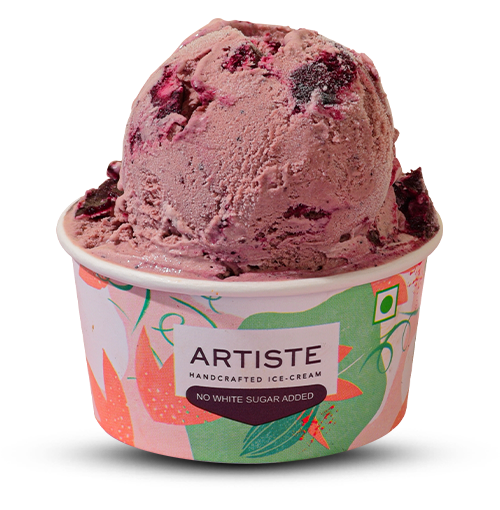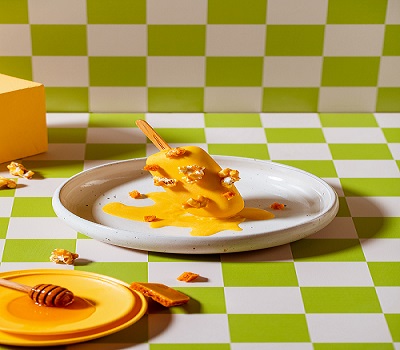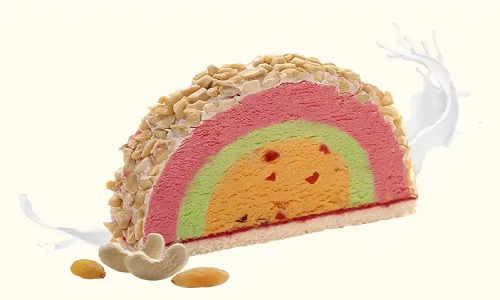BY- BASMA
According to a recent report by the International Market Analysis Research and Consulting Group (IMARC), the ice cream market in India stood at a whopping ₹194.1 billion as of 2022 and is set to reach ₹508.4 billion by 2028. Of this, about 50% are impulse ice cream purchases; the rest are focused on the niche customer base. Presently, take-home ice cream holds the largest portion of the overall market share, but there is a noticeable upward trend in the consumption and popularity of artisanal ice creams.
Well, what are Artisanal ice creams? Artisanal ice creams are handmade, preservative-free, artificial flavour-free, and use only natural and fresh ingredients. They do not contain stabilisers or emulsifiers, and unlike industrial ice cream, they have a shelf life of 5–10 weeks, as opposed to commercial ice creams, which can remain unscathed for 6–24 months.
With purely organic and healthy ingredients, artisanal brands have set a keystone example for commercial brands in creating a perfect combination of taste and health. The nourishing and delectable taste is almost impossible to imitate with chemicals, artificial flavours, and preservatives. As quality always wins over quantity, artisanal brands have been able to soar higher and higher.

Intemperance
I recall being utterly captivated by the ice-cream carts in my neighbourhood, particularly when our friendly ice-cream seller would announce his arrival with a familiar whistle. This memory has become a recurring motif for me, evoking a sense of nostalgia that endures to this day. Varieties like ‘softy’, ‘mango dolly’, ‘ice lolly’, and ‘cassata’ were beloved by all, serving as delightful reminders of carefree days gone by. Even now, reminiscing about those ice cream treats brings back waves of joyous nostalgia for many of us.
Yet, the pace and benchmarks of our lives have undergone significant changes in the last three decades. While traditional ‘old school’ ice creams continue to dominate the market in suburban areas, Tier II cities, and beyond, bustling Indian metros are experiencing a gradual ice cream revolution. This trend is elevating artisanal ice creams and ice cream makers to prominence, displacing mass-market brands like Amul, Vadilal, and Kwality Walls.
My initial encounter with an unconventional ice cream took place at Natural’s, where I indulged in an Alphonso mango flavour that instantly won me over. What struck me most was the absence of synthetic flavours and the perfectly balanced texture—neither too solid nor too liquid. Such a combination was a rarity at the time. Today, artisanal ice cream makers are leveraging this understanding of ice cream, blending it with old-school nostalgia, and emerging into the spotlight.
The emergence of new age ice cream trends

The distinguishing factor for artisanal ice creams lies in their meticulous attention to technical detail and intricacies, setting them apart from traditional commercial ice creams. The notable shifts in India’s ice cream consumption revolve around expanded flavour options, utilization of natural ingredients, preference for milk over hydrogenated vegetable fat, acceptance of pricing, and the emergence of brands incorporating special ingredients.
Initially, the ice cream market was predominantly occupied by classic flavours like vanilla, chocolate, and strawberry, with mango, butterscotch, and kesar pista following closely behind. However, this has undergone a significant transformation with the growing popularity of artisanal ice creams, leading to a surge in demand for fresh fruit flavours. Today, numerous brands specialize in crafting small-batch ice creams using premium ingredients, including exotic ones. These brands also cater to specific dietary requirements, such as high-protein and sugar-free options, contributing to an ice cream revolution in India.
A key driver behind the increasing demand for unique ice cream flavours is the desire among families to reconnect with their roots, explore their cultural identities, and be healthy at the same time. For instance, I have a unique fondness for kulfi, a dessert with roots tracing back to mediaeval times when refrigeration methods were non-existent. Traditionally, kulfi is made by flavouring milk, slow-cooking it to reduce it, and then cooling it, either in modern freezers or using improvised methods like insulated dug-up holes.
Today, kulfi has undergone a transformation, often served with a modern twist and the convenience of urban ice cream parlours. This appeals to individuals like myself, who have experienced displacement from their cultural origins yet find solace and nostalgia in signature flavours like almond and pistachio kulfi served on wooden sticks—a hallmark of Northern Indian heritage.

Artisanal ice creams serve an abundant diversity of flavours, including conventional ones like vanilla, chocolate, and many more. What makes it stand out from the rest of the queue is the variety of ‘not-so-popular’ tastes. The perfect balance strikes with a well-thought-out infusion of sweet, salty, sour, and bitter flavours that feel like an explosion of flavours. Flavours like sea salt chocolate and ginger pineapple might seem like absurd combinations but are tremendously popular customer choices. Such amalgamations are pre-planned and curated with lots of effort and knowledge, which is rare to find in commercial set-ups.
So, how do these flavours come together?
One example of archetypal artisanal ice cream is Icekreamskee, which is made with unique ingredients like cinnamon, sea salt-vanilla, lemongrass with ginger praline, traditional Gujarati ukaado, and much more under their label. At the end of the day, it is all about giving the consumer a taste of a flavour profile that they may not have experienced before. Another artisanal ice cream brand, Trayog, says that one of its key creatives comes from international ice cream flavours not seen in India, such as popcorn or black sesame. Another source of motivation comes from traditional Indian sweets, something that many artisanal ice cream brands are going after.
Trayog has also taken inspiration from flavour combinations that people love, not necessarily in desserts or sweet forms. This source of inspiration has given it the most shocking and polarizing flavours, such as sol kadhi (a tangy Maharashtrian dish with kokum and buttermilk) and garam masala (a roasted, ground blend of multiple spices).
Then the artisanal ice cream brand Cold Love is known to use pure, fresh, natural, and high-quality ingredients. Cold Love ice creams are crafted exclusively from natural ingredients, including milk, cream, sugar, and real fruit, without any chemicals, added colours, or artificial flavours. The ingredients are meticulously sourced from reputable suppliers and companies and packaged in high-grade materials to ensure hygiene and quality. Before churning and freezing, the ice cream mix undergoes cooking at high temperatures to guarantee safety and eliminate bacteria. Cold Love has brought in exclusive flavours including Boozy Bailey’s, Pink Guava Sorbet, Spiced Walnut and Rum, and Coconut-Jaggery.

Similarly, Artiste is another homegrown ice cream brand that explores earthy and inventive flavours. Artiste aims to promote natural, clean, and preservative-free eating habits, and its ice creams are meticulously handmade and churned in small batches to achieve a smoother, creamier texture.

Then Burma Burma’s new range of artisanal ice creams has unusual flavour combinations. The caramelised chocolate and cheese ice cream is fantastic—a great combination of creamy, caramelized white chocolate ice cream and Basque cheesecake with a surprising hint of tart raspberry gel to cut through the sweetness. They also have an unusual Durian Fruit Ice cream and an Avocado and Honey Ice cream.
What Naturals is to Mumbai, Pabrai’s Fresh, and Naturelle are to Kolkata. A family-owned business that has now blossomed into an icon, they make my favourite tender coconut ice cream, and their most beloved and decadent offering has to be their Nolen Gur flavour.
Ice cream manufacturers are increasingly catering to customers with dietary restrictions, offering a wide range of options from dairy-free to sugar-free. Unlike the limited selection typically found in mainstream brands, these ice creams now boast an extensive variety. Artisanal ice creams are targeting India’s urban, young, health-conscious, and progressive-minded individuals, as the ice creams are free from added sugar, preservatives, artificial sweeteners, or colours. Moreover, they boast a significantly lower fat content, approximately 60% less than conventional ice creams.
While nostalgia certainly influences consumer preferences, there is ample opportunity in the market to introduce unconventional and unique flavours in ice creams. Currently, although this trend is not yet widespread, it is steadily gaining momentum.
The preference for natural ingredients is currently confined to a specific demographic, primarily located in metropolitan areas. However, this consumer base is gradually expanding and is projected to increase significantly in the coming years.
Challenges
As compared to the commercial bulk-producing ice cream brands, artisanal brands are quite young in the market. Still, at a budding stage, the brands are more susceptible to market fluctuations than the former. With the pandemic hitting, many small artisanal ice cream start-ups were forced to shut down their operations, and those that survived this huge jolt faced a tremendous financial crunch. Another major problem is the sheer waste of products that the industry has to deal with.
Artisanal ice creams are perishables, and as already mentioned, most of them lack chemical preservatives that would’ve otherwise increased their shelf life by several fold. In such cases, the wastage of products due to priory unforeseen factors is a cause for concern for these small-scale producers. Therefore, the journey of artistic brands was never a bed of roses.
While the artisanal makers are here, one cannot deny the fact that the popular flavours will continue to flourish in the mass market. However, the unconventional take on ice- cream in India is certainly here to stay. The growth of such ice creams is slated to rise steadily in India. Rising disposable incomes would also contribute to more individuals being willing to pay more for a nostalgic, authentic flavour experience of dishes that aren’t readily available, albeit via ice cream.
There is also a school of thought that considers artisanal flavours to be a fad, but most believe that it won’t be so if chefs push the envelope in terms of the perception behind ice-cream flavours. The audience in India is more eager to experiment with flavours, and it’s time to see if the makers cater to them before the trend melts away.

Customer Trust
Many a time, there is no direct interaction between the consumer and customer in commercial backdrops, and it is mostly about a buy-and-sell relationship. On the other hand, artisanal brands incorporate personalized small tokens of emotion in their unique ways. For instance, many of these brands, while delivering their products, add a small note with the names of customers, explaining how valued and cherished they are! These gestures build a strong foundation of trust between these cottage brands and their customers. In turn, the latter is retained and increases the brand value as well. It is needless to say that such tokens can’t be expected from commercial ice cream brands.
What do the figures say?
In 2019, the global market for artisanal ice cream brands was estimated at USD 1.62 billion and is expected to rise to USD 9.92 billion by 2026! This means a ravishing growth of 7.1% CAGR between 2019 and 2026. In India, the picture is equally promising, with the market seeing a gradual yet powerful rise in popularity. According to a report, from 2020 to 2027, the market is expected to see a growth rate of 14.10% CAGR. Such tremendous growth can be attributed to social media influencers, health bloggers, and other influential personalities coming forward to support these products on their merit. The innovative branding, aesthetics, and health-conscious approach are the icing on the cake.
Editors pick
Since more people are searching for distinctive, premium goods manufactured with natural ingredients, consumer tastes and preferences for artisanal ice cream have changed. Ice cream that is produced by hand in small amounts using conventional techniques frequently includes ingredients that are purchased locally.
Although these goods are frequently more expensive than generic ice cream, consumers are nevertheless prepared to pay more for the superior quality and flavour. In order to develop complicated and one-of-a-kind flavours like mochi ice cream, fried ice cream, pistachio ice cream, scoops ice cream, protein ice cream, and avocado ice cream, an increasing number of ice cream producers are currently experimenting with high-end innovative flavour combinations. Also, artisanal ice cream frequently uses fewer ingredients and is free of artificial preservatives, flavours, and colours, which appeals to customers seeking healthier alternatives. As a result, a lot of new, independent small ice cream businesses are opening up and becoming more well-known.
From 2022 to 2030, the Asia-Pacific Artisanal Ice Cream market is anticipated to expand at a CAGR of 8.33%. The rise of middle-income groups in emerging nations and the rising per capita disposable income are to blame for this. In addition, the Indian artisanal ice cream market had the quickest rate of growth in the Asia-Pacific region and held the greatest market share.
Artisanal ice cream has reached the voting age in India, with chefs both small and big cheering it on. Customers also aren’t complaining about handmade ice creams. The Godrej Foods Trends Report 2023 Collector’s Edition, based on the contributions of over 200 chefs and food experts, notes that close to half (48.3 percent) of the culinarians foresee artisanal ice cream as the preferred choice for dessert for the next decade. Artisanal ice creams are delicate darlings; handmade and curated in small batches, they have a shelf-life of about 12 hours. The vegan versions are made with organic ingredients, are probiotic-rich, diabetic-friendly, and sugarless.
So many great gourmet ice-cream brands have arrived. With interesting new flavour combinations and a product quality leagues ahead of commercial ice cream, artisanal ice cream is here to stay, and the cool customers agree.


